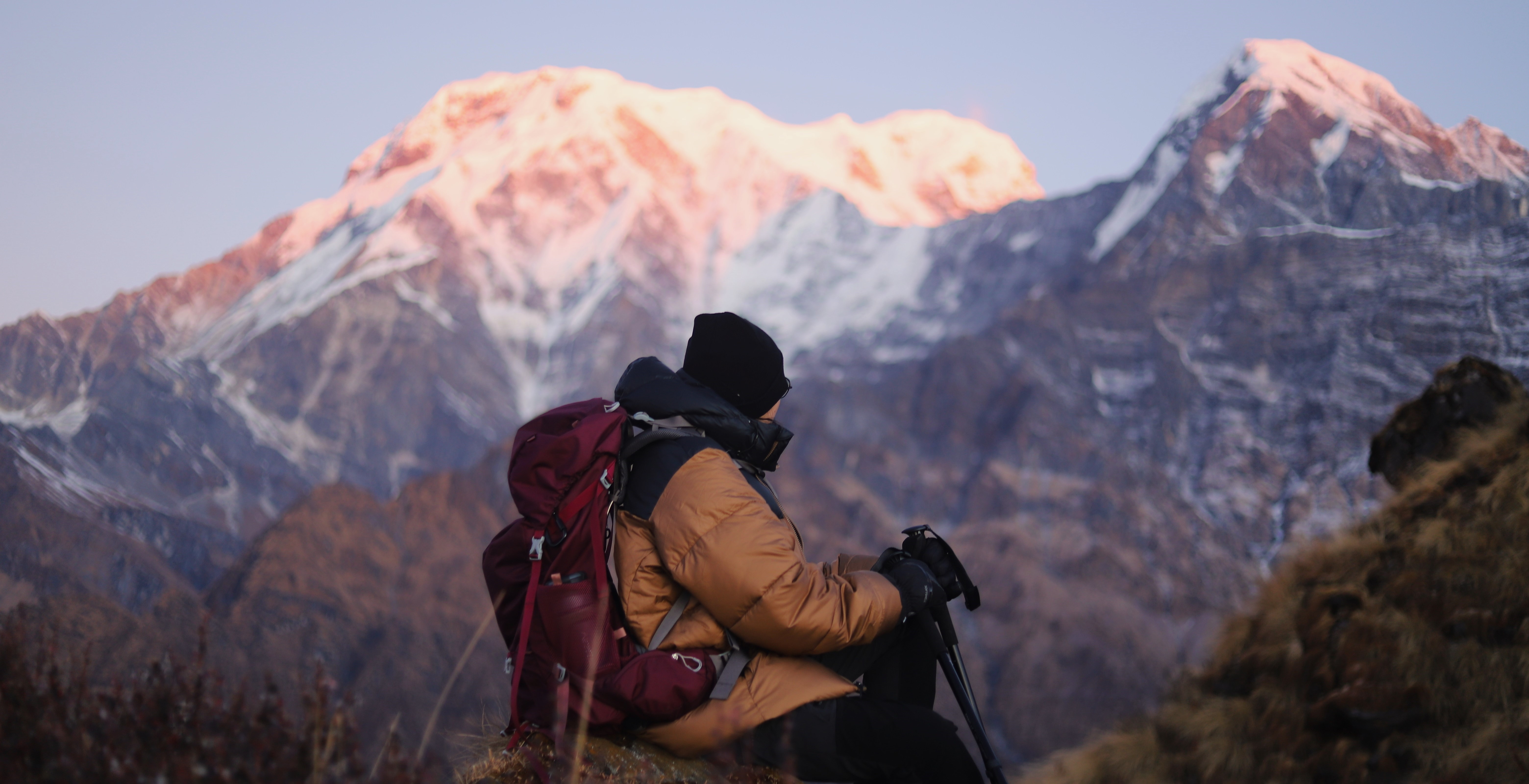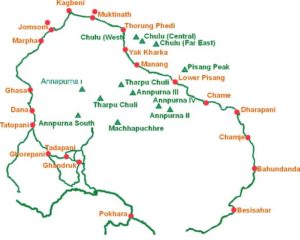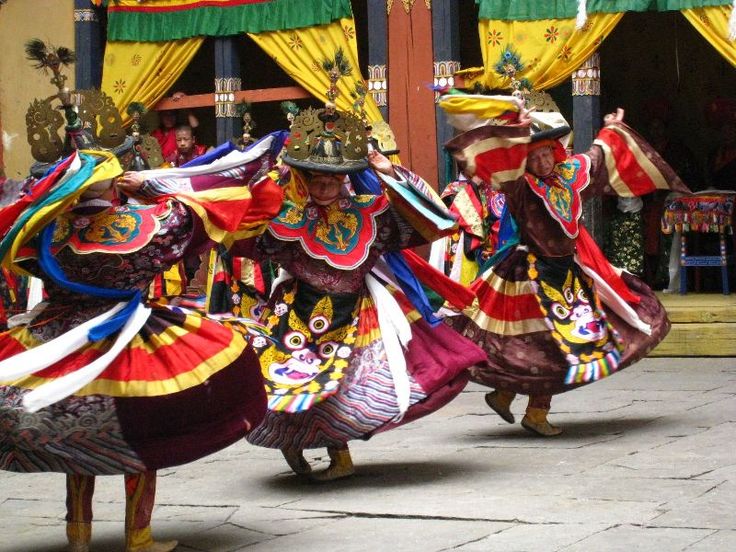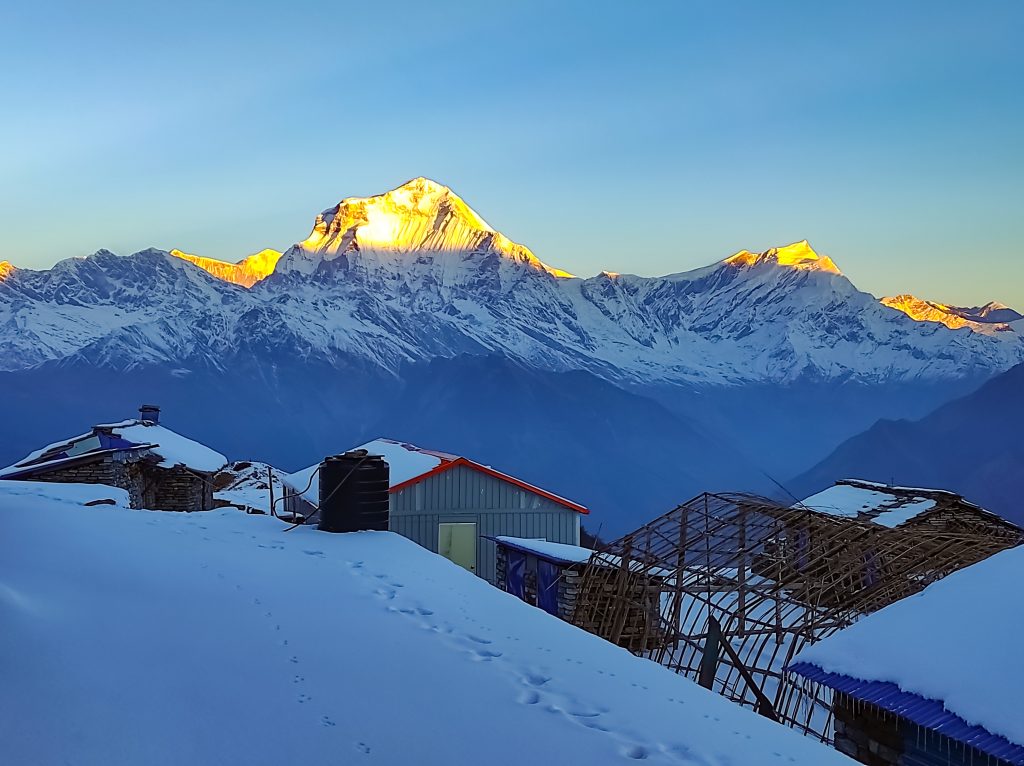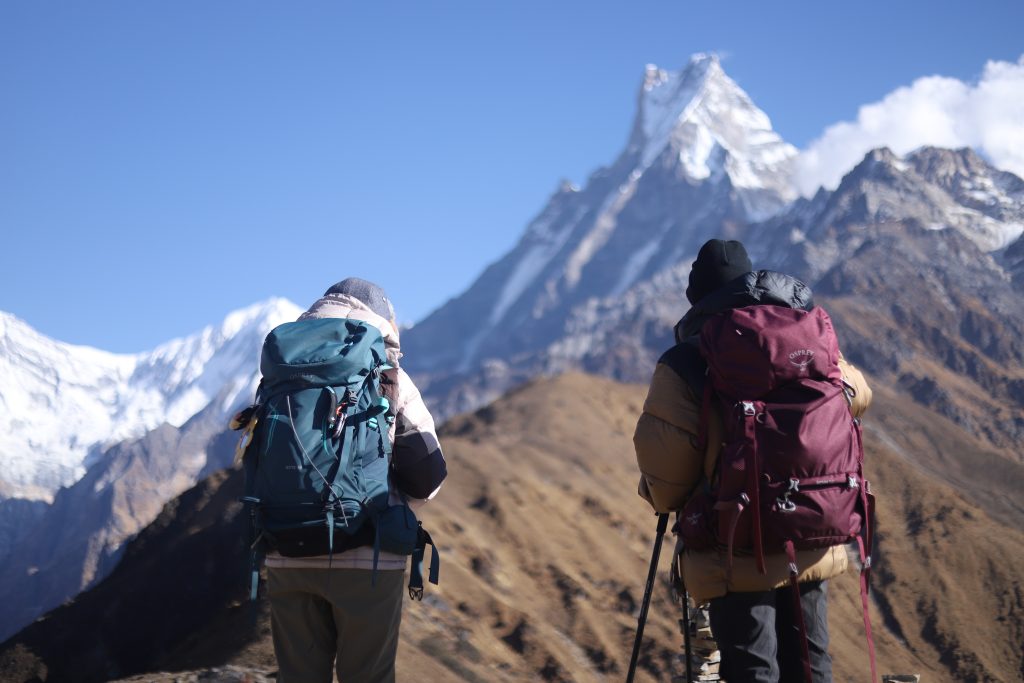Annapurna Circuit Trek
Annapurna region in the north-central part of Nepal offers a variety of trekking options and is widely known as one of the most geographically and culturally diverse trekking region. Annapurna Circuit Trek is one of many famous trekking in the world. Usually this classic trek starts from Besisahar. It takes about six to seven hours by private vehicle to reach Besisahar from Kathmandu. Beginning from the Marshyangdi river valley, the trek comes to an end in the world’s deepest gorge Kali Gandaki Gorge. Often been picked for the best long distance trek in the world, Annapurna circuit has wide variety of climate zones from tropics at 600 meters asl to the arctic at 5416 meters above sea level. Needless to say culture differs from Hindu community at the low foothills to the Buddhist community at the upper highlands especially at Manang valley and lower Mustang.
Annapurna Massif is linked with Pokhara on the south. Trek to Annapurna is famous because of the number of other mountains that come visible during the expedition. Thirteen peaks above 7000 meters and sixteen others over 6000 meters along with the world’s tenth highest mountains Annapurna I are the ultimate treat to your eyes while you are continuing your journey. Annapurna I, II, III, IV, Mt Machhapuchhre and Mt. Dhaulagiri are some major mountains to name. The total route length is assumingly 160 km and the whole trek takes 12 days including the seven hours drive from Kathmandu to Besisahar. The trek is rated medium in terms of difficulty which indicates that any person with average health fitness level can go for it. It is ideal for beginners as well as the pros. The Annapurna Conservation Area has been playing a major role in the preservation of different wild flora and fauna. The region is a place of fascination for many people. The landscapes vary widely as you gradually ascend uphill. You can stop and have lunch in a tea house or even a private house. People in the Himalayas are friendly and polite. Prayer flags are visible everywhere in the region. Buddhism is the major religion people follow here in this part of Himalayas. Some of the different districts you will pass through are Lamjung, Mustang, Manang and Myagdi. While the higher regions Manang and Mustang have people following Buddhism, the lower regions Lamjung and Myagdi are predominantly Hindu. The highest elevation of the trek is at the elevation of 5,416 meters above sea level called Thorong La Pass which is also the world’s highest pass. Since the trek is considered moderate, any person who can walk at least 5-7 hours a day can achieve the goal of this Annapurna Circuit Trek. However, it is advised that every group of trekkers carry a basic safety kit just in case. Spring (March-May) and autumn (Sep-Nov) are the best time for this classic trek. For further information on pricing and itinerary details, please call us or send us an email with your query through our website.
Himalayan Gateway Trek is a reputed adventure travel company that has been serving thousands of trekkers from all around the world. We are situated in Thamel, Kathmandu ,registered under license number 2126/073. Bunch of experienced guides and focused stuff has made the company this trust worthy up to date. The company is under the supervision of Mr. Bipin Lamichhane (Head) which has been providing facilities such as Trekking, hiking, tours and peak climbing. We are fully approved and licensed under Ministry of Tourism, Government of Nepal. We are also an active member of Trekking agents association of Nepal (TAAN), Nepal Mountaineering Assocation (NMA).
1, When you confirmed the trip,you should pay 25 % (Non- Refundable) down payment from total trip cost in advance as per the company’s policy, it help us to reserve Hotel’s in city, domestic flight’s and all other trip arrangement’s for final trip booking. with your deposit we need your details of scan passport copy by e-mail for all trips in Nepal, Tibet, Bhutan,which is more secure for you to book flight ticket or more things in your real name, gender, date of birth and passport number with home address.
2, All clients are request to have a valid passport, relevant visa/s and conform to the health regulations required by the country/s that will be visited during the trip.
3, You should clear rest of the amount on your Arrival day.
Any trip booking Payment process is very easy with Himalayan Gateway Trek (P.) Ltd, We accept your last minute booking also, but you should pay total tour cost in advance.
Insurance strategy takes care of the expense of a save helicopter from rocky or remote districts of the nation and covers all outrageous exercises for your excursion, for example, boating, endeavor, trekking, canyoning and so on.
On the off chance that you fall sick or have a mishap amid your trek in Nepal, the cost can end up noticeably over the top on the off chance that you need travel protection.
Numerous insurance agencies from everywhere throughout the world are giving travel protection administrations at a sensible cost and on the off chance that you are travlling in a gathering, you might have the capacity to get further rebates.
We firmly prescribe you to purchase a travel protection that comers Rescue and Evacuation at that point bring your strategy subtle elements (eg approach number, contact telephone, scope, and so forth) since save administrations will seldom go to your guide without money store or a guarantee in Kathmandu however when you are doing visit with us, we orchestrate helicopter departure in crisis case because of height ailment or enduring damage amid campaign/trekking/Climbing or potentially wellbeing conditions.
You have to either send your duplicate of travel protection approach authentication or basically convey alongside you amid your excursion. Himalayan Gateway Treks don’t offer or mastermind any kind of Travel Insurance Policy.
At long last, please dependably have a printed duplicate of your protection strategy helpful while going in Nepal
High mountain ranges such as the Himalaya and Andes offer some of the most spectacular hiking opportunities on the planet. That being said, walking at high altitude brings with it certain inherent risks. Good advice is to make sure that you are well prepared for the trek since lack of fitness can often lead to discomfort or illness. The most common health issues that trekkers have during the trekking is altitude sickness so we should always ready for these risks. Something as simple as a foot blister can totally ruin a trek, not only for you but also for your companions.
You are healthy and mental and physical wellness at the season of booking this visit
A standout amongst the most well-known grievances endured by guests to Nepal is stomach issue. Drink just packaged beverages with the seals in place, boiled and filtered water. Maintain a strategic distance from extremely spicy foods in the event that you are unused to it.
Before beginning, do warm-up activities. Extending slowly builds heart rate, temperature and flow to your muscles. Likewise, following a decent night’s rest, your muscles require warming.
Altitude sickness is the name given to the collection of symptoms which can happen, when a man endeavors to rise too rapidly at heights over 2500 m (8202 ft). If you take the necessary precautions and listen to your body, chances are you will be fine.
Wearing good, comfortable and softened up footwear will go far to dodging foot issues like blisters which is one of the probability issues among trekkers.
You should have taken the necessary precautions to immunise/vaccinate for the destination you are travelling to. If you fail to comply with the duty of disclosure in this condition and if Escape Trekking Adventures would not have permitted you to undertake the tour, or continue participation of the tour, had you made full disclosure under this condition, Himalayan Gateway trek will not be liable, except to the minimum extent.
Medical survival kits are often a boring subject and many hikers don’t give it much attention. However, a survival kit is one of the most important items you carry and should not be compromised. Carry a first aid kit with you. Every outdoor person must have a personal first aid kit with proper medical background information inside, namely: emergency contact info, blood type, allergies and current medication. Trekkirs should carry followings things.
->Analgesics. Aspirin, Advil or Tylenol – for headaches etc.
->Thermometer (to check for fever) – mercury thermometers are prohibited by airlines
->Anti-diarrhoeal drug
->Antibiotic eye drops (one bottle)
->Anti-inflammatory drug
->Tweezers (for removal of splinters)
->Adhesive waterproof tape (3-4′ long of 1″ wide tape rolled onto a popsicle stick or sewing thread bobbin)
->Safety pins (2 large pins; can be used for gear, to secure bandages, dig out a splinter, etc)
->Medical gloves (1 pair, nitrile surgical or non-latex barrier gloves; the sanitary option if you need to help someone that is bleeding, or you want them to help you!)
->Muslin Triangular Bandage in a compressed package (handly as a sling of to fashion different types of splints)
- • Fleece beanie
• sun glasses
• Chap stick / Sunscreen
• Face mask or Scarf
• Hand towel
• Wind stopper / waterproof top and bottom
• Cold weather down jacket below waist
• Fleece jacket and trouser
• Trekking trouser
• T-Shirts(short or long sleeves) dry fit is better
• Polypropylene thermal tops and bottom, at least 2pairs,
• Wind stopper and fleece gloves
• Socks and under wears
• Trekking boot
• Snow Gaiter (optional)
• Runners / Snickers for camps
• Head torch
• Personal medical kit
• Water Bottle/Camel Pak
• Trekking / Ski pole (optional. Handy for anyone with knee problem)
• Spare batteries for Camera andflash light. Check charging facility along your journey
• Day pack Minimum25L with side pocket for water bottle
Tourist who intends to visit Nepal must hold a valid passport and visa.
You may get your tourist visa in your home country or on arrival. We recommend you to get your tourist visa on arrival as it is very easy. To get your visa on arrival, you must have a valid passport and 2 passport sized photo with a light background.
Tourist Visa fee for visitors who enter Nepal for the first time in a visa year, from January to December:
- Multiple entry visa for 15 days US$ 30
- Multiple entry visa for 30 days US$ 50
- Multiple entry visa for 90 days US$ 125
Tourist visa extension facility:
- Visa extension fee for the period of 15 days us US$ 30
- Visa extension fee for the period of more than 15 days US$ 2 per day.
- Visa can be extended for a maximum period of 150 days in a visa year (January – December) at the Department of Immigration.
No visa required for:
- Children below 10 yrs.
- Any foreigner, who has stayed in Nepal up to fifteen (15) days continuously and re-enters Nepal during the same visa year.
- Any tourist who is entering Nepal for three days or less.
Entrance fees must be paid before touring heritage sites around Kathmandu Valley
| Foreigners | SAARC | Nepalese | |
| Narayanhiti Durbar Museum | Rs. 500 | Rs. 250 | Rs. 100 |
| Kathmandu Durbar square | Rs. 750 | Rs. 150 | free |
| National Museum Chhauni | Rs. 200 | Rs. 25 | Rs. 20 |
| Patan Durbar Square | Rs. 500 | Rs. 100 | free |
| Patan Museum | Rs. 250 | Rs. 25 | Rs. 10 |
| Patan Golden Temple | Rs. 50 | Rs. 20 | free |
| Mahabouddha Temple | Rs. 50 | Rs. 30 | free |
| Bhaktapur Durbar Square | Rs. 1,500 | Rs. 500 | free |
| National Art Museum, Bhaktapur | Rs. 100 | Rs. 50 | Rs. 20 |
| Swayambhunath Stupa (Monkey Temple) | Rs. 200 | Rs. 50 | free |
| Bouddhanath Stupa | Rs. 250 | Rs. 150 | free |
| Pashupatinath Temple | Rs. 1,000 | Rs. 1,000 | free |
| Changu Narayan Temple | Rs. 100 | Rs. 25 | free |
| Ethnographic Museum, NTB | Rs. 200 | Rs. 100 | Rs. 30 |
Entrance permits fees for National parks and Conservations areas
| Foreigners | SAARC | Nepalese | |
|---|---|---|---|
| Makalu-Barun national park Sagarmatha national park Langtang national park Rara national park Shey Phoksundo national park Khaptad national park |
Rs. 3,000/person +13% VAT | Rs. 1’500/person + 13%VAT | free |
| Bardia National Park Parsa Wildlife Reserve Koshi Toppi Wildlife Reserve |
Rs. 1,000/person | Rs. 500/person | Rs. 50/person |
| Chitwan National Park | Rs. 1,500/person | Rs. 500/person | Rs. 100/person |
| All Conservation Areas | Rs. 2,000/person | Rs. 200/person | free |
Jungle drives / vehicle entry fees
| Car | Jeep | Van | Chopper | |
|---|---|---|---|---|
| Chitwan National Park | Rs. 2,000/day | Rs. 4,000/day | Rs. 5,000/day | Rs. 5,000/landing |
| Parsa, Shuklaphanta Koshi Tappu wildlife reserve |
Rs. 1,000/day | Rs. 2,000/day | Rs. 3,000/day | Rs. 5,000/landing |
Himalayan Gateway Trek usually books hotel accommodation for you in cities on Bed and Breakfast basis as your requirements. During your trek you can stay in a local tea house or camp. It depends on your wishes. While you are on a tea house trek, Himalayan Gateway Trek invites you to choose the food you like for your breakfast, lunch and dinner from the menu. Our experienced guide will help with selecting and ensure that you get hygienically prepared, plentiful and healthy food. Most tea houses offer a variety of rice and noodle dishes, as well as seasonal vegetables. A variety of cereals, bread and egg dishes are generally available for breakfast, properly Hot drinks like Tea/coffee,Hot chocolate and others are available with all meals, and you can also buy mineral water in most of the areas where you find tea houses.
Tour Highlights
- Trip Grade
- Duration17
- Starting PointBeshisagar
- Ending PointNayapul
- TransportationBus/Private Car/
- Group Size1-20
- MealsBreakfast in kathmandu and Pokhara/3 meals during trek
- ActivitiesTea house/Lodge
- Trek StyleTea House
- Max. Altitude5,416m
- Best TimeMarch to may and september to December
